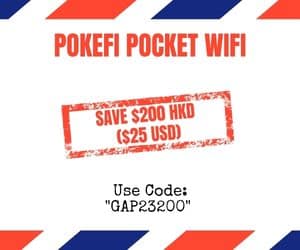With your dream vacation booked to French Polynesia in the South Pacific, you’ll feel like your trip can’t come fast enough but before you know it, your flight is days away and you need to figure out what to pack to Tahiti. In order to help you in this moment of panic (trust me, I had the same panic attack), this islands of Tahiti packing list will break down all the things you need to think about when it comes to what to put into your backpack and/or suitcase.
Read
Where did we stay in Bora Bora?
- The ultimate question right? Thanks to the magic of Marriott Bonvoy, I was able to book a reward stay at Le Meridien Bora Bora for an epic 6 nights in an overwater bungalow. The reviews for the property are here.
Table of Contents
Looking for something specific in this packing list? Jump to what you want to read.
In This Article
The Islands of Tahiti Packing List
As many of you already know, I love sharing with you guys my packing list because it’s one of those things that always stresses me out before going on a new adventure. Did I bring the right things? Did I forget anything? What am I not thinking of? Do I need to buy anything last minute? Maybe I should look at someone else’s packing list like this one from the CDC?
The goal of this packing list is to guide you through things you should think about before you go
If you’re regulars on Going Awesome Places and you’ve seen my other packing lists for places such as Egypt, New Zealand, or Inca Trail. This time, I wanted to do things a little different and instead of covering everything under the moon, I wanted to call out specific packing list items that I thought were really critical for the type of trip we did. The goal of this islands of Tahiti packing list is to guide you through things you should think about before you go so you don’t have any “oh shit” moments when you’re already in-destination.
The packing list is a highly personal topic because each one of us travels in a specific way. We all have different experiences with travel, travel styles, and overall preferences. Another thing that is going to vary wildly between each person is the itinerary in the islands you’ll be visiting and the activities you’ll be doing while out there.
Of course, things will also be very different between men and women and obviously I’m a little biased here because I’m a guy.
Alright, let’s jump right into how you should pack for your trip to the islands of Tahiti (aka French Polynesia).
Bags and Organizers

Let’s start off with what I’m going to call bags and organizers. While some of these will be pretty obvious, I’ll try to explain why some of these are unique to French Polynesia and why you should think about packing these.
You can follow the image above from left to right.
- The Islands of Tahiti beach bag – Now really any kind of bag will do but we found that having an open beach bag like this was super handy at Le Meridien and even when we were out on our own in say Rangiroa when we wanted to go to the nearby beach. It’s perfect to throw in snorkelling gear and large towels. Why this was clutch for us in Bora Bora was because Le Meridien actually doesn’t provide free beach bags in the room.
- Olympus CS-35 waterproof wrap cloth – This has honestly been sitting in my closet for years and I thought this would be the perfect thing to protect my GoPro rig and it worked really well because I could just wrap, tie it together, and throw it in the waterproof bag.
- Peak Design Travel Backpack – While I wasn’t doing any serious hiking here, you can call this my main carry-on bag for flights and primary carrier of all of my camera gear. It’s paired with the Peak Design Capture clip and large camera cube.
- Generic waterproof dry bag – I’m lucky that I had this from a previous trip but I found this to be a must-have considering the amount of scuba diving we did in French Polynesia (Bora Bora, Rangiroa, and Fakarava) and the amount of flash tropical raining we had given it was rainy season. For diving, I threw in my camera gear in here, dive log, wallet, towel, extra batteries etc. The 15L was big enough to even fit the 6L sling!
- Sea to Summit TravellingLight Hanging Toiletry Bag – This is my go-to toiletry organizer. It’s small, lightweight, and fits everything I use except for my electric shaver.
- Peak Design 6L Sling – This is the latest version of slings by Peak Design and my first time taking the 6L out with me. I LOVED this bag and ditched the bigger backpack for this as a daily carrier of my camera body with lens, microphone(s), wallet, memory cards, batteries, and whatever else I needed on resort or when I was out diving.
- Peak Design Shoe Pouch – Nothing fancy about this other than being the bag I used to keep my Keen sandals. Shoe bags are important for a trip like this because of the amount of sand that’ll be all over. When travelling between islands, you’ll need to put your extra shoes in pouches like this so they don’t get all over your suitcase or backpack.
- Peak Design Tech Pouch – If you take a look at my Egypt packing list, you’ll know exactly what I have inside. Things haven’t changed a whole lot. This fits inside the Travel Backpack and has all the dongles/adapters/cables for my laptop and other electronic gadgets.
- Sea To Summit 1L Dry Sack – This has the same purpose of the larger dry sack but is meant for organizing smaller things such as batteries and memory cards. I guess you could call this waterproof redundancy for anyone doing more of the water activities in places like Bora Bora.
Air Tahiti Carry On Warning
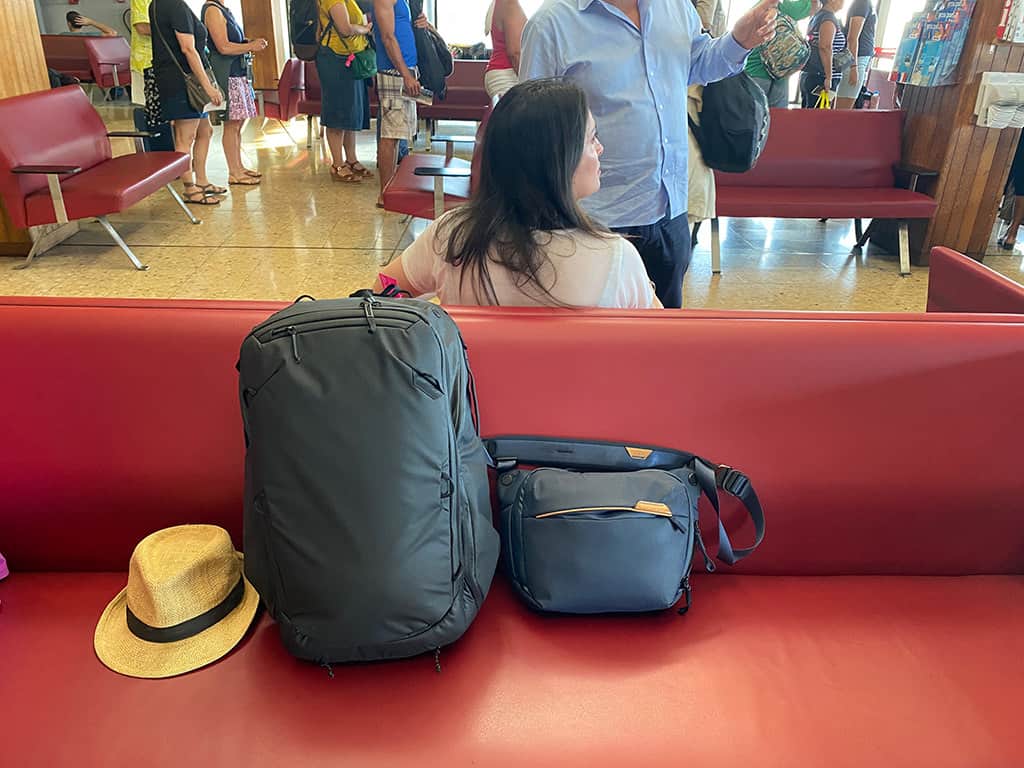
There are several learnings from my trip in regards to inter-island flights within French Polynesia that I strongly urge you to pay attention to. The rules are written on Air Tahiti but in practice there are some nuances you should know about.
- Check-in luggage is the standard 23kg so that should not be a surprise and only one piece per person.
- Officially only one piece of carry-on is allowed (from the photo above, I somehow got away with two when flying from Tahiti to Bora Bora). If you’re trying to pull off something like me, I recommend a sling bag that you can compress and stow away in a larger bag. I did exactly that with the 6L Sling after I learned my lesson in Tahiti.
- Inter-island flying is domestic and as such there is no security. This means that you can carry liquids with you on your carry-on as you wish.
- Carry-on weight restrictions are only strictly checked in Bora Bora where the limit is 5kg. My Travel Backpack was closer to 9kg but when I told them it was all camera gear, they seemed to soften their stance and allow it through. That said, when we were sitting at the gate, we saw that the staff were constantly scanning carry-on luggage to make sure everyone was within size and weight limits. They even pulled someone aside to double check their weight. I was approached as well but again mentioned camera gear and let me off the hook.
- With the above said, Tahiti was the only island where this was strictly enforced. On Bora Bora, Rangiroa and Fakarava, they didn’t check carry-on bag weight at all.
Underwater Camera Gear

Usually I leave my camera tech gear near the bottom of the list but because these are things you’ll most likely need to buy before your trip, I’m surfacing this to the top so you can squeeze in those last-minute purchases in like I had to for this trip to the islands of Tahiti.
Telesin 6″ Dome for GoPro Hero8 – Every wonder how people get those half underwater and half above-water shots? Well the secret are these domes and for this trip since I knew I had a bit more time to play with this, I ordered one to arrive just in the nick-of-time. While the quality is a bit suspect and it took some time to figure out how to use it properly, I definitely came away with a couple of cool shots with it.
- Underwater LED fill-light for GoPro – I purchased two of these as fill-lights for the GoPro video I wanted to shoot while diving. I quickly learned that these lights are really only good for macro shooting (i.e. fish in coral, clown fish, and fish in caves) as opposed to capturing sharks or dolphins. These are cheap and serviceable.
- Aluminum hotshoe mount adapter for GoPro – I did some research and many people recommended these adapters for diving so I grabbed two to work with the diving rig I purchased.
- Movo GB-U70 Underwater Diving Rig for GoPro – In my hunt for something affordable for my GoPro, I stumbled upon this which was the most compact and easy to use rig out there that could also accommodate lights. I was very happy with this on the trip especially after I figured out how to mount the GoPro a little further up with the help of the tripod mount.
- Scuba Diving Dive Camera Lanyard Clip and Buckles – On previous trips, I always had a very basic GoPro stick set up but that meant having it dangle around your wrist while diving. With a strap like this that clips into your BCD, you can be handsfree with the camera if you’re not using it and when you are, you’ll always have the comfort that it’s tethered to you.
- Phone dry bag – I only used this when paddle boarding and kayaking in Bora Bora but it’s good to have in case you need it.
- GoPro tripod mount – This GoPro mount was necessary to push the GoPro a bit forward on the diving rig because otherwise it had issues working with the PolarPro Switchblade.
- GoPro Hero 8 – As GoPro’s latest action camera, I was very happy with its performance and stabilization capabilities.
- GoPro Shorty – I have so many different types of poles for GoPro but this one is perfect for travel. It doesn’t go out super far but is enough for any selfie videos you want to do and it can turn into a tripod.
- PolarPro Switchblade 8 – I was really excited to use this because it has the flexibility of shooting macro and also having a red filter for deep water. The honest review of this is that it’s incredibly well constructed but for the type of diving we were doing in French Polynesia, I felt that I was never shooting macro and was never deep enough to really make use of the red filter.
- GoPro Hero 8 Battery – 2 batteries are enough for a trip like this especially if you’re only doing 2 tank dives each day.
- GoPro Hero 8 SuperSuit – This is Hero 8 specific and a necessary part of the kit if you want to go scuba diving with your GoPro. You need the official case if you want it to work with the Switchblade.
- GoPro Jaw Clamp and Gooseneck – I used this in two scenarios on the trip – fixed to the diving boat and while riding the bicycle. There was also thought that we might do some ATV. It’s a flexible mount for those looking to get b-roll video.
Photography and Videography
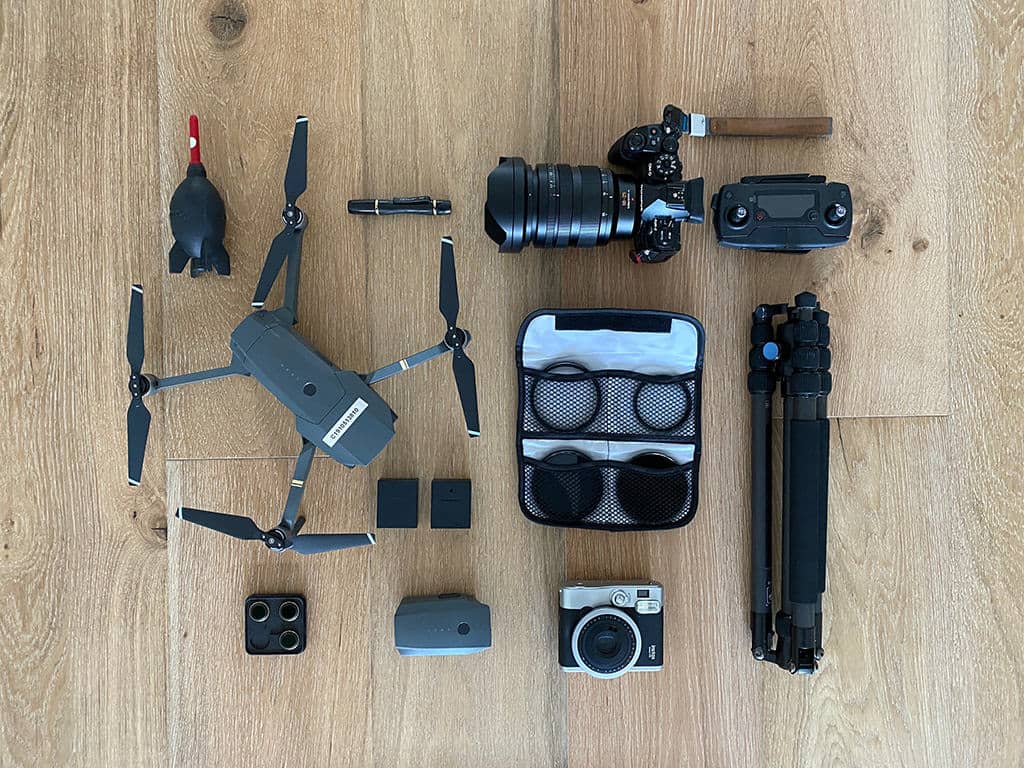
When it comes to photography and videography, I’m always looking to minimize my kit as much as possible. While I brought a few more things than what you see here, I’ve sorted through what I think are must-haves and maybe one nice-to-have in here.
If you’ve watched how I converted from full-frame to m43 video, you know that I’m a huge fan of Olympus cameras. I definitely feel like an outlier here but the micro four thirds system is truly something that helps me break free of excess weight, complicated gear, and in many cases the tripod as well.
- Rocket Blower – I know it’s a bit bulky and bulbous but is great for quick cleaning.
- DJI Mavic Pro Drone (Gen 1) – This is still my trusty drone and more than enough for the aerial photography I got a chance to do and a couple of flights I did for b-roll video.
- PGYTech Mavic ND Filters – If you’re doing any sort of video with your drone, these are going to be more-or-less glued to your Mavic.
- LensPen – Like the rocket blower, this is going to be critical to keep your lenses clean.
- Olympus BLH-1 Batteries – I brought way more batteries than what you see here but I wanted to make a point to say that it felt like I really only needed a rotation of 2 batteries on this trip (3 to be safe) because I was always charging every night.
- Mavic Pro Battery – I’ve travelled with my drone quite a bit at this point and I can safely say that you’ll only ever need a maximum of two batteries with you. Any more is overkill.
- Olympus OM-D EM-1 Mark 2 – I’ll be replacing this soon with the Mark 3 and has been my workhorse for photo and video for 4 years now.
- Panasonic Lumix G Leica DG Vario-Summilux 10-25mm f/1.7 M43 Lens – Man that’s a long name! This is my latest purchase and really put it to the test on this trip. I was incredibly impressed with the versatility of this lens whether for photo or video. One of the big knocks on the M43 system is depth of field and at f1.7, this produced the smoothest bokeh. As a one lens travel lens it does very well but there were a couple of times when I missed the reach of the 12-40mm and the wideness of the 7-14mm Olympus lenses.
- Set of UV, Cir-Pol, and ND Filters – One of the benefits of the Panasonic 10-25mm lens is that it has a 77mm thread which is frequently used by other popular lenses. I also played around with the Manfrotto Xume filter quick-switch system but sadly I had to ditch it because of the vignetting it was creating at the wide end which is where I was shooting most of the time.
- Instax Mini90 – Totally a nice-to-have but it’s something we’ve been doing on our travels lately to create tangible photo souvenirs.
- Sirui T-024X Carbon Fibre Tripod – I still don’t have the Peak Design Travel Tripod to test so until then, this is still my go-to travel tripod.
Staying Fully Charged

Most of what I have here isn’t a surprise but wanted to bring a few things to your attention that really helped me to never miss a beat when it came to batteries.
- Eagle Creek Pack-It Pouch – This is just a multi-purpose bag I can throw all of these things inside that don’t fit in the Tech Pouch.
- Belkin 3 Outlet Travel Surge Protector – This thing must be 10 years old but still works incredibly well. It’s a little bigger than I’d like but was such a godsend to have because it has USB outlets for charging and enough outlets to plug in my laptop, drone battery charger and any other blocks I had with the key that I didn’t need an outlet adapter for each.
- Skross Europe Plug Adapter – I have many adapters but for Europe this one’s the best quality and important that it fits the round receptacle perfectly.
- DJI Mavic Pro charger – This one’s also been handy to have because it has two USB outlets built-in.
- GoPro dual battery charger – Dual battery chargers are key.
- RAVPower 61W Wall Charger PD 3.0 – I recently upgraded my Apple MacBook block with this one because it’s significantly smaller and lighter.
- Dual battery charger for Olympus BLH-1 – I had a much larger one before but this one’s nice and compact since you can only charge via USB.
- Anker Powercore II 10000 Power Bank – There weren’t many times that I needed a power bank on this trip but this is always good to have in case.
Easy to Forget

These are a few of the more miscellaneous things but I wanted to call these out specifically because they were all important to have on the trip for the itinerary we put together.
- Scubapro Mask – If you’re going to invest in gear for scuba diving, the mask is one of the first things to get because it’s small to pack and is important to make sure it fits your face well so you don’t have any leaking or visibility issues.
- Rainbow Flip Flops – The best pair of flip flops you’ll ever own. I used these on most occasions unless I needed something more rugged. These are also great to fit any sort of dress at the resort.
- Diving certification card and dive log – Don’t forget these before you go!
- Dive computer – Second to the mask I’d say a good dive computer is a good investment. Go for something small like the Oceanic OCS that can also double as a regular watch.
- Maui Jim Chee Hoo Sunglasses – Ask any optician, Maui Jim lenses are the best in the market. I also have the straps on them too since I find they help with the photography/videography I do.
- UCO Leschi Lantern and Flashlight – This was a last minute addition but glad we brought it. At the pensions (Tahitian Guesthouse) we stayed at in Rangiroa and Fakarava, there wasn’t a lot of light between the buildings and so it was convenient to have this small light in our pocket to light our way. This is a neat one because you can use it as a flashlight or you can use it as a lantern that casts a wider light.
- Victorinox Swiss Army Classic SD – You have to remember to put this in your check-in luggage but a handy tool to have.
- Sports towel – I packed this as an emergency but this actually did come in handy. For instance, The 6 Passengers in Rangiroa doesn’t provide towels so this was clutch. Tahitian guesthouses also only provide bath towels so if you are looking to do any water related activities on your own, you’ll need your own towel so you don’t mix the same towel between fresh and salt water.
- Keen Newport H2 Sandals – I’m glad I packed this because French Polynesia is very “coral-ey” so something like this will keep your feet safe and be a bit more versatile as well because you’d be able to use this for other outdoor activities while giving you the proper ventilation.
- Outdoor Research Radar Pocket Cap – A hat that’s pocketable – genius!
Shirts
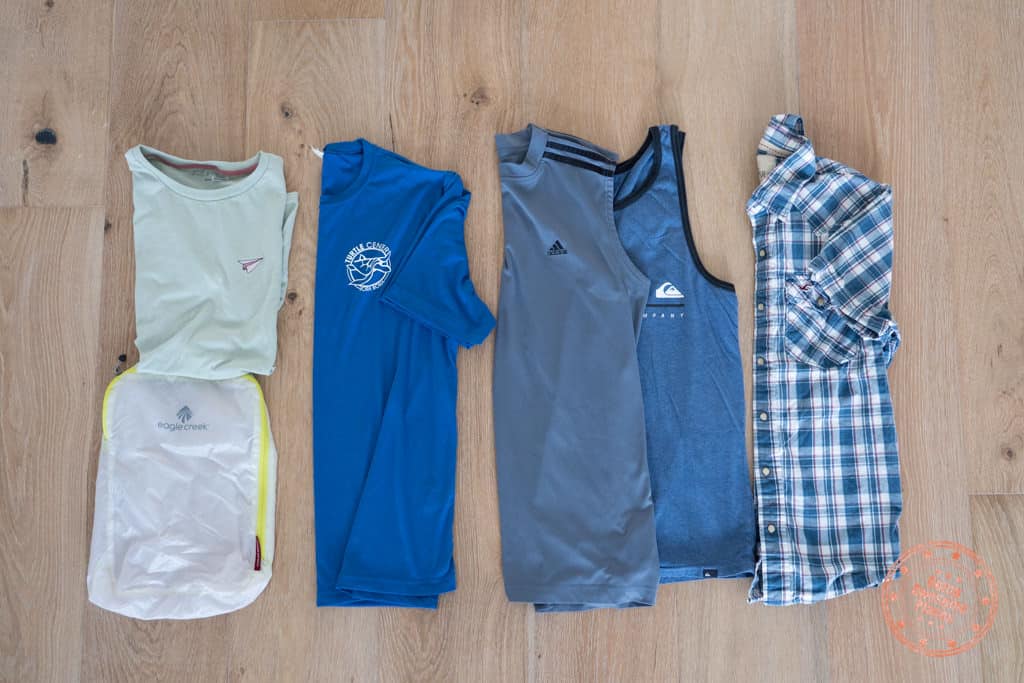
Now onto the more personal items that will really vary from person to person. Let’s start with the shirts. Note that I’m not showing everything here but wanted to speak to each type of shirt I brought.
- T-shirts – Oh I love my t-shirts. I definitely brought way too many of them. I packed 8 and I think I really only needed 5 or 6 since we were so good about hand-washing our clothes almost every other day.
- Eagle Creek Pack-It Specter Cube – The perfect bag to put your rolled up t-shirts.
- Quick-dry sports t-shirts – I only packed one but in retrospect I should’ve packed more because it was really hot during the day.
- Sleeveless shirts – I packed 3 sleeveless shirts and to work on that even tan, this was a good number.
- Buttoned shirts – I packed 3 nicer buttoned shirts primarily for evening dinners at the resort. 2 I think would’ve been enough since these weren’t useable at all once we got to Rangiroa and Fakarava.
Pants

When it comes to bottoms, this is what I think you need as a guy going to the islands of Tahiti.
- Shorts – I brought a mix of comfy and nicer shorts but 3 was just right for a 2 week trip itinerary.
- Long pants – I packed 1 for the flights and also nights when I didn’t feel like getting bit by mosquitos at night.
- Swim trunks – I packed 2 swim trunks which I thought would make things tight but it turned out to be fine. After using them for diving or snorkelling each day, I would wash them and hang them out to dry which made them ready for the next day or I could just wear the other pair.
- Versatile shorts/trunks – That last pair on the right is the amphibious shorts that I probably could’ve worn more but I didn’t just because I found myself usually in my swim trunks. Still, this is useful to have.
Underwear

- Ex-Officio Boxer Briefs – Packed 8 of these but honestly only needed 5 for a trip like this because it was so easy to hand-wash and hang dry.
- Socks – I know, what’s so special about this? I didn’t need the hiking socks at all because of the activities we ended up doing and instead of the 6 socks I brought, I really only needed 2 to 3.
- PJs – These are easy to forget when packing.
Toiletries
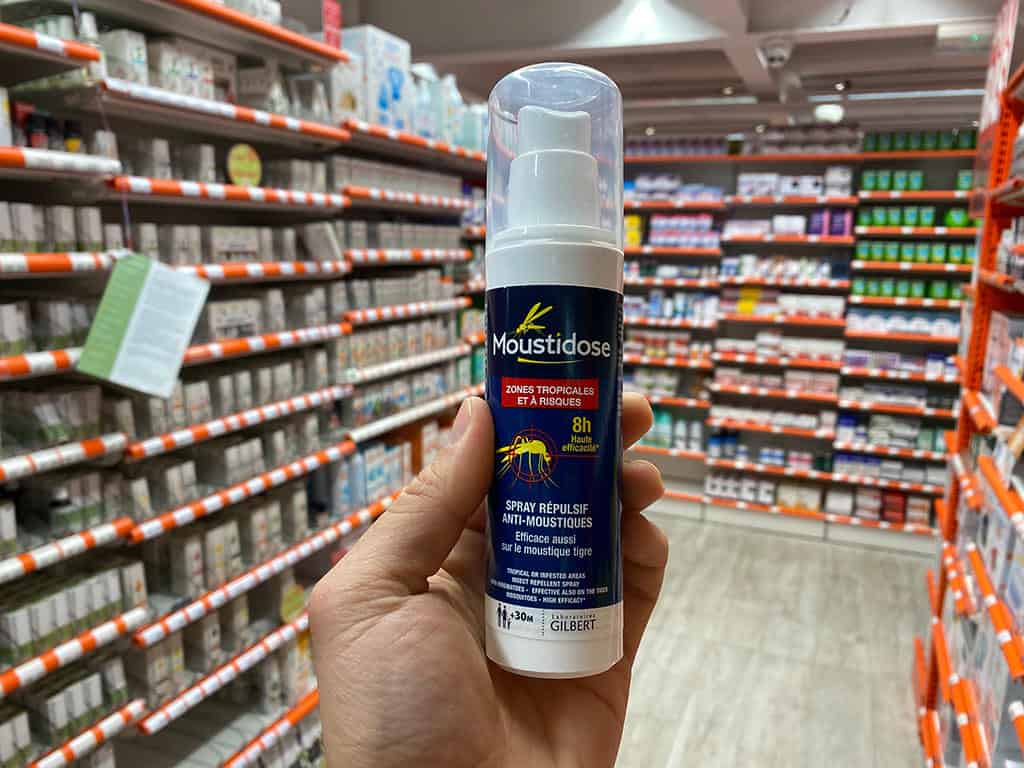
This time, I didn’t want to break down everything for toiletries so here’s a quick reminder of a couple of items that you’ll want to make sure is in your bag.
- Mosquito repellent – Yes, mosquitos are definitely out there especially when you’re not staying in an overwater bungalow. Make sure to either buy repellent before you leave or pick up local French repellent that was recommended to us, Moustidose.
- 50SPF Sunscreen – Reef-friendly Sun Bum is what I’d recommend. We went through roughly 2 8oz bottles over 2 weeks.
- Dramamine – If you get nausea easily while on a boat, remember to pack this.
Everything Else

Here are a few remaining things that are worth noting.
- Book – I normally don’t pack books but on this trip it was actually a really nice change of pace to be able to spend time on the beach or wherever to read a book.
- Keen Explore Vent – What’s awkward about a trip like this is that you still need a full shoe for flying.
- Full-brimmed hat – It is a beach vacation after all ;)
- BUFF Headwear – Not depicted here but one of my go-to packing items is my BUFF. I never go anywhere without it.
Honest feedback from the trip
Having spent 2 weeks in French Polynesia, I realized how the packing for the trip in retrospect was more complicated than I had originally thought.
I say that because when putting together the packing list, I was primarily thinking about Bora Bora and our stay at Le Meridien which means packing nicer clothes for the resort but once we got out to the Tuamotu Archipelago in Rangiroa and Fakarava, all of those things were completely useless.
Being out of the resort also meant that we needed to be much more self-sufficient as the Tahitian guesthouses were definitely a bit more barebones. Also, you can’t assume that every place will have free snorkel rentals like at the big resorts. We realized this at Pension Paparara which is why we didn’t end up going snorkelling from our beach.
How was it travelling in rain season?
Since we travelled to the islands of Tahiti during rainy season, we felt those effects throughout the trip. While we were on Tahiti, we faced heavy rains throughout our time there but luckily we both packed lightweight rain jackets.
On Bora Bora, Rangiroa, and Fakarava, we didn’t face the type of torrential rain we faced in Tahiti but there were bouts of sporadic rain that would come in hot and heavy but only lasted a few minutes to half an hour.
When you travel during rainy season, you have to go expecting that you’ll see rain at some point but you’ll be able to weather it pretty easily because you’ll be able to hang out in your overwater bungalow or you’ll be underwater diving where you won’t even notice it.
What about data?
On most trips, I recommend packing a pocket wifi device like the PokeFi (save $200 HKD with GAP23200) to make sure you’re connected the whole time.
For French Polynesia, the truth is, you’ll never truly feel like you need data because you are out there to relax and disconnect. There weren’t really any specific instances where I needed a connection to do something but I do have an interesting breakdown to get yourself thinking about whether you need anything special or not.
Did we need data?

While at Le Meridien Bora Bora, their wifi coverage was so good throughout the resort that you really didn’t need cellular data to stay connected.
In Rangiroa and Fakarava, your data needs really depends on how good the wifi is at your guesthouse. For us, Chez Taia et Vero in Rangiroa had great wifi and so the only time we needed data was when we hopped on our bicycles to ride into town. At Pension Paparara in Fakarava, the wifi they offered was only available in the dining/lounge area which made it more challenging but we made do.
The only place I felt like I might’ve needed data more than anywhere else was on the main island of Tahiti. Since there was only wifi at our apartment,
Local pocket wifi suggestion

Tahiti Wifi is pretty much the only player in town when it comes to renting wireless hotspots. They have a very convenient booth at Faa’a International Airport (PPT) connected to all of the car rental companies. Their pricing structure is pretty simple and comes with an Android-based hotspot that’s a simplified smartphone with a touchscreen.
- 7.90 EUR/day – 1GB per day and then throttled to 512 kbps afterwards
- 24.90 EUR/day – Unlimited high speed 4G/3G
- 49.90 EUR – 5GB for 30 days
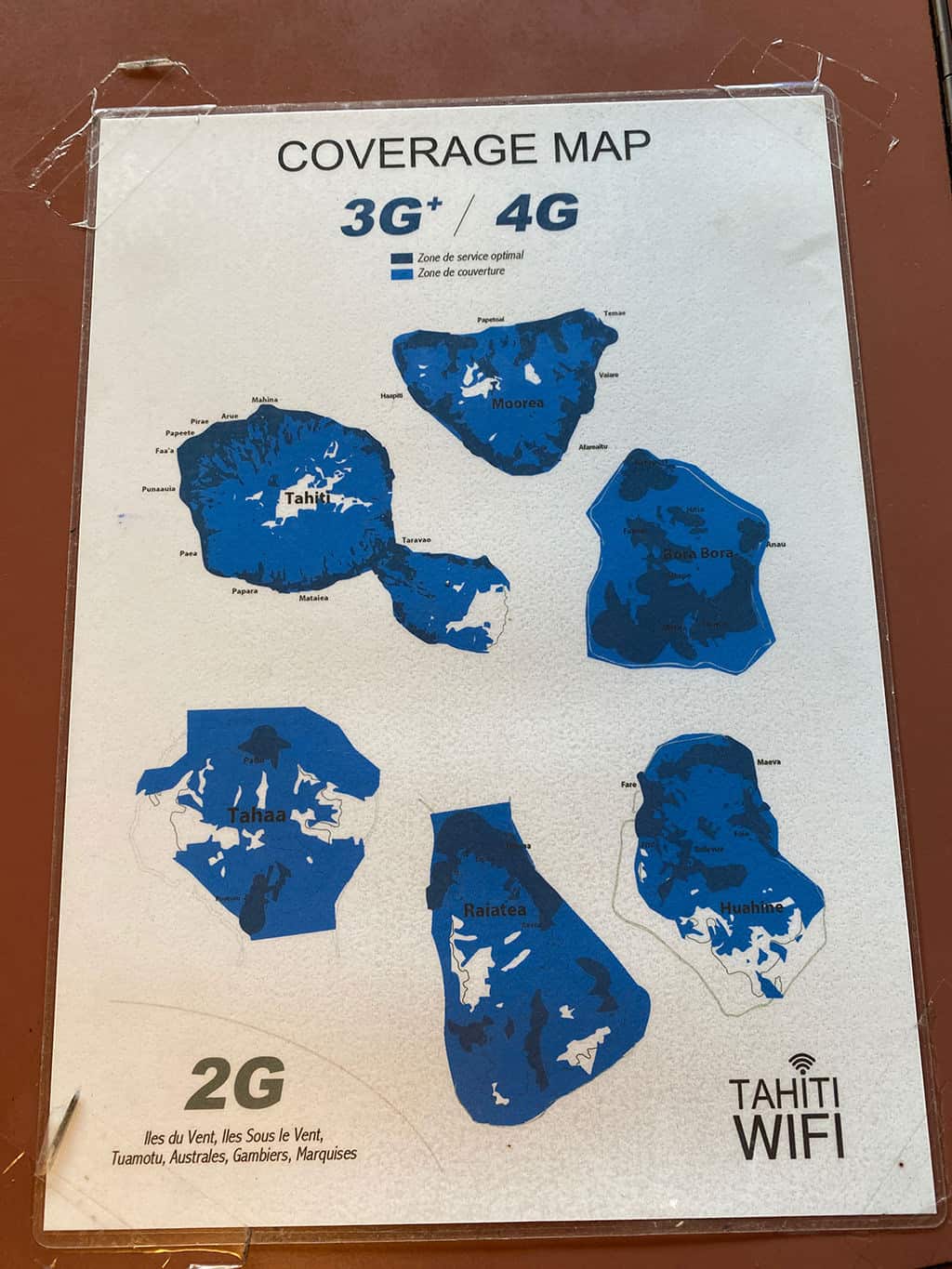
Something you do need to take into consideration is the coverage. All of the islands here (all Society Islands) has solid 4G connection down to 3G. All other Society Islands and archipelagos have 2G or no coverage at all. For our islands of Tahiti itinerary, there was coverage in Rangiroa but nothing in Fakarava. I spoke to the Tahiti Wifi staff about this and they said they are adding Fakarava later in 2020.
The other thing you need to keep in mind is that you also need to return the device at the end of your trip on Tahiti.
If you’d prefer to get a SIM card, they offer Vodafone at these rates:
- 5GB is 6000 XPF
- 2GB is 2000 XPF
Getting set up at home

If you’d rather have a solution set up and ready to go before you leave home, I’d recommend that you take a look at Pokefi.
I tested Pokefi while I was out there and I had signal on Tahiti and Bora Bora but it did not work on Rangiroa and Fakarava. In my speed tests, it was 2G speeds at best so don’t expect it to be fast.
The benefit of PokeFi is that you can buy data bundles ($15 USD for 5GB) instead of paying by the day and any excess can be used at future trips while the data bundle package with Tahiti Wifi (49.90€ EUR for 5GB) is restricted to your trip.
Travel Insurance
I never travel without travel insurance and even though French Polynesia is incredibly safe, you never know when you need it.
In Canada, we typically go through RATESDOTCA to make sure I can find the cheapest rates for travel insurance. Another place that’s always worth checking is World Nomads.
Have specific questions about your own islands of Tahiti packing list as you prepare for your trip? Don’t hesitate to drop a comment below and I’ll get back to you as soon as I can!
What you should read next
 Telesin 6″ Dome for GoPro Hero8
Telesin 6″ Dome for GoPro Hero8